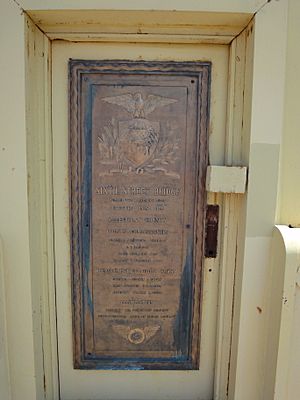Roberto Clemente Bridge facts for kids
Quick facts for kids Roberto Clemente Bridge |
|
|---|---|

The Bridge with Downtown Pittsburgh in the background.
|
|
| Coordinates | 40°26′44.1594″N 80°0′11.8794″W / 40.445599833°N 80.003299833°W |
| Carries | Sixth Street |
| Crosses | Allegheny River |
| Locale | Allegheny, Pennsylvania, United States |
| Official name | Roberto Clemente Bridge |
| Other name(s) | Sixth Street Bridge |
| Named for | Roberto Clemente |
| Maintained by | Allegheny County |
| Characteristics | |
| Design | Suspension bridge |
| Total length | 884 ft (269 m) |
| Height | 78 ft (24 m) |
| Number of spans | 3 |
| Lua error in Module:Location_map at line 420: attempt to index field 'wikibase' (a nil value). | |
The Roberto Clemente Bridge, also known as the Sixth Street Bridge, crosses the Allegheny River in downtown Pittsburgh, Pennsylvania, United States. It's a famous landmark in the city.
Contents
History of the Bridge
First Bridge (1819)
The very first bridge at this spot was built in 1819. It was a wooden covered bridge, which means it had a roof and sides, like a tunnel. This bridge had six sections.
Second Bridge (1859)
In 1859, a new bridge was built by John A. Roebling. He was a famous engineer who also designed the Brooklyn Bridge. This was his third and last bridge in Pittsburgh.
This second bridge was made of wire cables. It had two main sections that were about 344 feet (105 m) long. The bridge was taken down in 1892 because it was too narrow and not strong enough for the growing city's traffic.
Third Bridge (1892)
The third Sixth Street Bridge was built in 1892 by engineer Theodore Cooper. This bridge was much wider than the one before it. Its main sections were 440 feet (130 m) long.
In 1927, this bridge also had to be removed. Its steel parts were becoming too weak to be safe. Parts of this bridge were floated down the Ohio River to Neville Island. They were then used to help build the Coraopolis Bridge. The rest of the steel was recycled in 1994.
Current Bridge (1928)
The bridge you see today was finished on September 29, 1928. It is one of Pittsburgh's famous "Three Sisters" bridges. The other two are the 7th and 9th Street Bridges.
These three bridges are very similar. They are a special type of suspension bridge. This means their roadway hangs from strong steel cables. These cables are anchored to the bridge itself, not to the ground. This was a new and clever way to build bridges back then. All three bridges were built by American Bridge (AB) company.
Why This Bridge is Special
The Roberto Clemente Bridge is named after Pittsburgh Pirates baseball legend Roberto Clemente. It's one of the "Three Sisters" bridges, along with the Rachel Carson Bridge and the Andy Warhol Bridge.
These three bridges are important for a few reasons:
- They are almost identical in design.
- They were the first "self-anchored suspension" bridges built in the United States. This design is unique because the main cables pull against the bridge deck itself.
- Pittsburgh has over 720 bridges, and these three are among the most famous.
When the bridge was first planned, its supports were built with arched openings. These were meant for future subway tunnels under the river. However, the North Shore Connector subway tunnels built in 2012 went a different way and did not use these openings.
The bridge was officially renamed on August 6, 1998. This happened after the Pirates baseball team sold the naming rights for their new stadium, PNC Park. Many people in Pittsburgh wanted the stadium itself to be named after Roberto Clemente. Naming the bridge after him was a way to honor the beloved player.
On days when the Pirates or Steelers have games, the bridge is closed to cars. This allows fans to walk safely across to PNC Park (where the Pirates play) and Heinz Field (where the Steelers play). A statue of Roberto Clemente is located near the bridge, right by PNC Park.
The bridge also looks amazing at night! It was lit up for the first time on November 20, 2002. This project was funded by several groups, including the Pittsburgh History and Landmarks Foundation.
Images for kids



